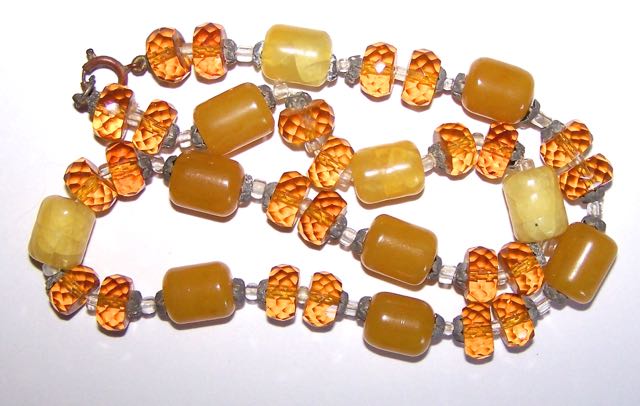| Some info on imitation amber beads made of Celluloid | |||||
| Post Reply | Edit | View All | Forum | ||
10/25/2017, 20:39:48
Floor found that some of the beads had deteriorated significantly in the last 30 years (see photo), and we documented her findings in a short article in the latest Bead Forum - the twice-yearly newsletter of the Society of Bead Researchers. Without being able to do any tests on the actual beads, I was still quite confident, just from the degraded appearance, that the beads were made of Celluloid - a nitrocellulose based plastic that dates from 1856.
After the article was published I was fortunate to be able to acquire a necklace (see photo) with Celluloid beads that are similar to the Jablonec beads and show the same deterioration. I tested the beads using a bead reamer inside the hole and detected the characteristic odor of camphor which was used as a plasticizer for Celluloid. So now I have 100% confidence in the identity of the Jablonec beads. You can also see that the metal bead caps (probably brass) are very deteriorated, and some are missing. When Celluloid degrades it gives off acid fumes that attack metal, paper, cardboard, etc. so storage of Celluloid items is challenging - if you have any Celluloid items they need to be kept dry, away from light, but with good air circulation so the acid fumes can escape.
The necklace appears to be a late 1800s to early 1900s design. The accompanying faceted amber glass beads are lovely - does anyone recognize the source? I purchased the necklace from a seller in France.
It's interesting that beads on the same necklace, and on the same bead card, show large variations in the amount of color change and fracture lines. I can only speculate that the beads may have been from different lots that had slightly different amounts of the chemical constituents and/or variations in the temperature reached during curing ( both very common occurrences in plastics manufacture).
So I have nothing new to report on phenolic beads from the African trade, but Floor and I hope to re-visit the Jablonec bead archives next year to continue the search for old plastic bead information.


Modified by Rosanna at Thu, Oct 26, 2017, 11:43:02
All rights reserved by Bead Collector Network and its users
|